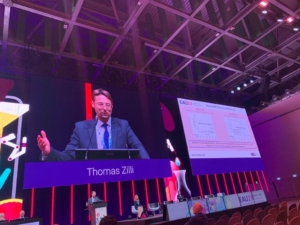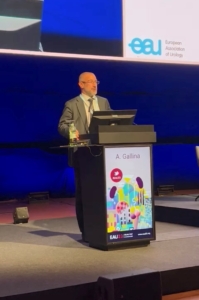- Highlights of the Annual Meeting of the European Urology Association (EAU) in Milan in March 2023
Urological highlights regarding prostate cancer diagnosis
Several note-worth novelties were covered during the meeting. This paragraph of the commentary focuses on two important topics for prostate cancer diagnosis. First, the role of PSMA PET/CT for the diagnosis of prostate cancer and its impact on clinical decision-making. Secondly, the use of artificial intelligence (AI) in interpreting multi-parametric Magnetic Resonance Imaging (mpMRI) and its effects.
A specific session of the congress was dedicated to the indication for prostate cancer biopsy and the additional benefits provided by positron emission tomography (PET), micro-ultrasound, and use of biomarkers. Dr. Philipp Krausewitz presented the study protocol and interim analysis of the DEPROMP trial, which focuses on the detection rate of clinically significant prostate cancer using mpMRI and PSMA-PET/CT fusion biopsy. The researchers hypothesized that PSMA-PET/CT could provide additional value for biopsy-naïve patients. The study aims to include 230 biopsy-naïve men with a high suspicion of prostate cancer based on criteria such as PSA level and suspicious digital rectal examination or ultrasound. Participants undergo both an MRI and a PSMA-PET/CT scan, followed by a fusion biopsy. The primary outcome measure is the incremental benefit of combining PSMA-PET/CT with MRI in influencing medical decision-making. Secondary outcomes include the detection of clinically significant prostate cancer, concordance between pre- and post-operative T-stage, and exploratory biomarker analyses. Preliminary findings from the interim analysis indicate that incorporating PSMA PET/CT-targeted biopsies alongside standard systematic and MR-targeted biopsies led to a 4% higher detection rate of clinically significant prostate cancer and a 2% decrease in the detection of non-significant prostate cancer. Furthermore, the inclusion of PSMA-PET/CT with targeted biopsies influenced therapy decisions in 53% of cases during the interim analysis. However, it is important to note that these results are preliminary, and final results are still awaited.
Additionally, Dr. Maarten de Rooij presented the preliminary findings of the PI-CAI challenge, which aims to evaluate the performance of AI and radiologists in detecting prostate cancer on MRI. The use of MRI prior to prostate biopsies is recommended, but it can lead to overdiagnosis and inter-reader variability. AI has the potential to assist in MRI interpretation, but its application requires robust scientific evidence. The PI-CAI challenge was designed to address these issues and involved a dataset of 10,207 cases from multiple centers. It consisted of two parts: Part 1 focused on developing AI algorithms through the PI-CAI Challenge with Artificial Intelligence Models, similar to clinical trials or “grand challenges.” This phase was hosted on www.grand-challenge.org, enabling the upload and validation of AI algorithms in a fully blinded setting. Part 2 involved the Reader Study with Radiologists, where prostate radiologists worldwide were invited to participate.
The primary endpoint of the study was the comparison between AI and radiologists, while secondary endpoints included AI versus AI and radiologists versus radiologists. The study encompassed a global cohort, with more than 830 individuals, over 60 AI teams, and 290+ AI algorithms submitted from 50+ countries. A total of 81 radiologists from 54 centers across 22 countries participated in the PI-CAI challenge. Preliminary findings showed that the top AI algorithms’ diagnostic performance, when trained on fewer than 2,000 cases, was comparable to that of radiologists reported in the literature. The comparison between AI and radiologists will be reported in the future. Future research should evaluate experience, workflow, image quality, and protocol familiarity.
Oncological highlights regarding systemic treatment options in urogenital cancers
1. The use of the radionuclide therapy 177-Lutetium-PSMA in the neoadjuvant setting in patients with high-risk localized disease planned for radical prostatectomy (RP)
177-Lutetium-PSMA-617 (Lu-PSMA) plus protocol permitted standard of care (SOC) has shown an overall survival benefit in the randomized phase III trial VISION in metastatic castration-resistant prostate cancer (mCRPC) after failure of one androgen-receptor targeted agent (ARTA) and one taxane compared to protocol permitted SOC (mainly second ARTA, corticosteroids or bone targeted agents)(1). Recently it has been approved also by Swissmedic, although logistics and lack of sufficient supply remains an important problem for assuring patient access to the drug. Lu-PSMA is in further evaluation in various clinical trials in monotherapy and in combination also in earlier settings, mainly in metastatic hormone-sensitive disease. An update of the phase I/II trial LuTectomy (2, 3) has been presented in one of the Game Changing sessions at EAU chaired by Prof Silke Gillessen. LuTectomy is a prospective phase I/II study of dosimetry, safety, and potential benefit of upfront [177Lu] Lu-PSMA-617 radioligand therapy prior to radical prostatectomy in men with high-risk localised prostate cancer. Dr Renu Eapen from the Peter McCallum Cancer Center in Melbourne presented the study results. 20 men were included in the trial. Six men had clinical N1 disease, and all patients had a significant uptake of PSMA, which was a clear inclusion criteria. The primary endpoint was dosimetry. Important secondary endpoints were efficacy (biochemical response, pathological response) and safety in this very early setting of Lu-PSMA use. The first cohort of 10 men received 1 cycle of Lu-PSMA, the second cohort received 2 cycles 6 weeks apart. After 6 weeks of end of treatment patients underwent their planned prostatectomy and radical lymph node dissection. The study demonstrated that a significant dose of Lu-PSMA could be delivered to the prostate gland and the PSMA positive LN (median of 36 Gy) and that there were no safety concerns to be noted regarding the following RP. This study gives reason to further proceed with research on Lu-PSMA in this early setting of localized disease. To date the study is for sure not practice changing and further results of larger trials have to be awaited as discussed by Prof Briganti from the Urology Department of the University of San Raffaele in Milan in the session. Another phase I trial, which included a similar trail population has been presented by Dr. Frumer Israel reporting 14 men receiving 2 or 3 neoadjuvant cycles of 177-Lu-PSMA only two weeks apart at the dose of 7.4 Gbq until one month before RP. (4) The study showed a dose dependent decrease in PSA that reached up to 34% after 3 LuPSMA doses. A decrease of > 50% in PSA predicted downstaging on RP final histology, but these were very small numbers (3/4 patients) and needs further validation.
2. Neoadjuvant chemotherapy (NAC) for muscle invasive bladder cancer (MIBC) – still many unmet needs to select patients who will have greatest benefit.
One of the top-tier and prize-winning abstracts was the abstract A1163 Proteomic profiling of muscle-invasive bladder cancer treated with neoadjuvant chemotherapy presented by Dr Reike from Vancouver, Canada.(5) Pre-NAC tissue was investigated in 107 patients with MIBC who received NAC followed by radical cystectomy (RC). SP3-Clinical Tissue Proteomics (SP*-CTP) were performed. The researchers identified 4 pre-NAC and 2 post-NAC proteomic clusters with distinct biology and survival outcomes that could be included in larger future trials with a prospective design for further validation.
Another abstract discussed in the Best of EAU 2023 session was abstract A0547 (6): Carboplatin induction chemotherapy in clinically lymph node-positive bladder cancer presented by Dr von Deimling. Cisplatin-based neoadjuvant chemotherapy is superior to Carboplatin as shown in various randomized trials and remains the SOC for treatment of MIBC patients fit for Cisplatin.(7, 8) However, for patients with clinical N1 disease unfit for Cisplatin cytoreductive pre-operative chemotherapy might have an impact to reduce the risk of metastasis pre-operatively. The authors showed their data on the use of Carboplatin/Gemcitabine in cN1 MIBC giving rational to consider Carboplatin-based chemotherapy in selected cN1 Cisplatin-unfit patients pre-operatively.
Oncological highlights concerning the best treatment management of patients with localized prostate cancer
During a plenary session on “best management” of prostate cancer patients in the early detection and active surveillance settings, Prof. Freddie Hamdy presented the updated 15-year oncologic outcomes of the PROstate TEsting for Cancer and Treatment (ProtecT) trial, while Prof. Jenny Donovan presented the long-term quality of life (QoL) results (both published at the same time in the New England Journal of Medicine and in its open-access version) (9, 10).
Randomizing 1,643 prostate cancer patients to active monitoring (n=545), radical prostatectomy (n=535) or definitive radiotherapy (n=545), the ProtecT trial was the first randomized clinical trial to report the long-term outcome of different management strategies in men with early staging prostate cancer. With a 15-years median follow-up, survival from clinically localized prostate cancer continued to remain very high (96-97%), irrespective of the treatment approach. Interestingly, the number of patients undergoing radical intervention in the active monitoring group continued to increase, with a 61% of patients initially randomized in the active monitoring arm receiving a definitive treatment. Although prostate cancer-specific survival remained equally high across for the different management strategies, the incidence of metastases, long-term androgen deprivation therapy use, and disease progression rates were all significantly worse in the active monitoring arm. Moreover, using validated QoL questionnaires, the ProtecT trial confirmed that the side effects of the different treatment strategies continue to impact the QoL of men with prostate cancer on the long-term. Each one of the three approaches is characterized by a specific toxicity profile: urinary leakage was more frequently observed at 12-year follow-up in patients treated with radical prostatectomy, while a worse bowel function was found in patients treated with definitive radiotherapy. The decline rate in sexual function at 12-year was similar between the three arms.
The updated data from ProtecT provide therefore further evidence in supporting prostate cancer screening and treatment especially in men with very long (>15 year) life expectancy. For these patients early identification and treatment of high-risk disease remains crucial. Importantly, the ProtecT data highlight that treatment decisions should balance the benefit in reducing the metastatic burden, long-term use of androgen deprivation, and local progression obtained with radical treatments against their potential impact on sexual, urinary, and bowel functions. Integration of technology advances such as mpMRI, PSMA-PET/CT, genomic classifiers, and other biomarkers are expected in the future to better discriminate and select patients benefitting or not of a specific treatment.
Important contributions from the multidisciplinary team members of the Prostate Center of Southern Switzerland (CPSI), Ente Ospedaliere Cantonale (EOC) in Ticino
Again, this year the specialists of the Prostate Center of Southern Switzerland (CPSI) were invited speakers and chairs at this important meeting and contributed to the great success of it.

Prof. Silke Gillessen, the director of the Oncology Institute of Southern Switzerland (IOSI), was chairing a plenary session with the focus on quality of life and palliative care in uro-oncology with a focus on the management of penile cancer as well as supportive care for bone pain and implementing strategies to offer patient support for their sexuality during androgen-deprivation therapy (ADT). She also chaired one of the Game-Changing Sessions with the objective of understanding the latest updates on freshly presented prospective studies on prostate cancer, one of those was the one we chose as a highlight in our article (phase I LuTectomy). Further she chaired a thematic session with important topics focusing on clinically meaningful questions on the clinical management of mHSPC.

PD Dr. Ursula Vogl (Clinical Head of the CPSI) had to challenge in a debate the contrary speaker with the pro argument for triplet therapy in mHSPC. The EAU also dedicated a thematic session to a joint session with the Advanced Prostate Cancer Consensus Conference (APCCC) were the president of APCCC Prof Silke Gillessen selected different topics in clinical management of advanced prostate cancer where high-level evidence is missing, opening space for potential research and clinical trials.

Prof Thomas Zilli (Head of the Radiotherapy Department at the IOSI) shared his expertise in a clinical case discussion arguing for a treatment approach with radiotherapy +/- systemic therapy. Prof Gillessen was also holding a lecture in the session of burning questions in oncological urology, shedding light on the current and future role of PSMA- based theranostics in men with advanced prostate cancer.
For the 9th time the European School of Oncology (ESO) held its Observatory with an outlook what will happen in the different fields of prostate cancer in the next 12 months. PD Dr. Ursula Vogl was chairing this session and covering the outlook what will be happening in the next 12 months in the field of medical oncology. The ESO with its main offices in Bellinzona and Milan has also created a Certificate of Advanced Studies (CAS) in prostate cancer in collaboration with the Università della Svizzera Italiana (USI),

offering a 2-year educational program in the field of prostate cancer. The Scientific Directors PD Dr. Ursula Vogl, Prof. Silke Gillessen, and Prof Andrea Gallina (head of the EOC urology department in Lugano) kicked-off the program at the EAU in Milan with a selected group of international young specialists working in the field of uro-oncology.
Prof Andrea Gallina gave a special lecture on robotic surgery for patients treated with radical cystectomy. He is a world-leading expert in this field and he recently started the program of robotic radical cystectomy in collaboration with his colleague Prof Nicola Fossati at the EOC in Lugano.
Oncologia medica
Ente Ospedaliero Cantonale
Viale Officina 3
6500 Bellinzona
Department of Surgery
Urology Service
Ente Ospedaliere Cantonale (EOC)
Lugano
Facoltà di Scienze Biomediche,
Università della Svizzera Italiana (USI)
Lugano,
- Sartor O, de Bono J, Chi KN, Fizazi K, Herrmann K, Rahbar K, et al. Lutetium-177-PSMA-617 for Metastatic Castration-Resistant Prostate Cancer. N Engl J Med. 2021;385(12):1091-103.
- Dhiantravan N, Violet J, Eapen R, Alghazo O, Scalzo M, Jackson P, et al. Clinical Trial Protocol for LuTectomy: A Single-arm Study of the Dosimetry, Safety, and Potential Benefit of <sup>177</sup>Lu-PSMA-617 Prior to Prostatectomy. European Urology Focus. 2021;7(2):234-7.
- O’Brien J, Alghazo O, Buteau JP, Eapen R, Jackson P, Mitchell C, et al. V098 – Salvage radical prostatectomy following 177Lu-PSMA-617 radioligand therapy in men with high-risk localized prostate cancer: Surgical aspects of the LuTectomy study. European Urology. 2023;83:S2010.
- Frumer M, Kedar D, Baniel J, Groshar D, Bernstine H, Yakimov M, et al. A1108 – Prostate Specific Antigen response to neoadjuvant Lutetium-177-PSMA treatment in high-risk localized prostate cancer patients. European Urology. 2023;83:S1604.
- Contreras-Sanz A, Reike MJ, Negri G, Htoo ZO, Spencer Miko S, Nielsen K, et al. A1163 – Proteomic profiling of muscle invasive bladder cancer treated with neoadjuvant chemotherapy. European Urology. 2023;83:S1678.
- von Deimling M, Mertens LS, Van Rhijn BWG, Lotan Y, Spiess PE, Daneshmand S, et al. A0547 – Carboplatin induction chemotherapy in clinically lymph node-positive bladder cancer. European Urology. 2023;83:S781-S2.
- Dogliotti L, Cartenì G, Siena S, Bertetto O, Martoni A, Bono A, et al. Gemcitabine plus cisplatin versus gemcitabine plus carboplatin as first-line chemotherapy in advanced transitional cell carcinoma of the urothelium: results of a randomized phase 2 trial. Eur Urol. 2007;52(1):134-41.
- Bellmunt J, Ribas A, Eres N, Albanell J, Almanza C, Bermejo B, et al. Carboplatin-based versus cisplatin-based chemotherapy in the treatment of surgically incurable advanced bladder carcinoma. Cancer. 1997;80(10):1966-72.
- Hamdy FC, Donovan JL, Lane JA, Metcalfe C, Davis M, Turner EL, et al. Fifteen-Year Outcomes after Monitoring, Surgery, or Radiotherapy for Prostate Cancer. New England Journal of Medicine. 2023;388(17):1547-58.
- Donovan JL, Hamdy FC, Lane JA, Young GJ, Metcalfe C, Walsh EI, et al. Patient-Reported Outcomes 12 Years after Localized Prostate Cancer Treatment. NEJM Evidence. 2023;2(4):EVIDoa2300018.
info@onco-suisse
- Vol. 13
- Ausgabe 4
- August 2023








